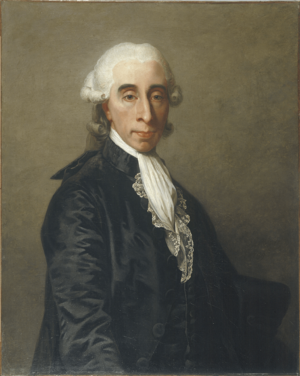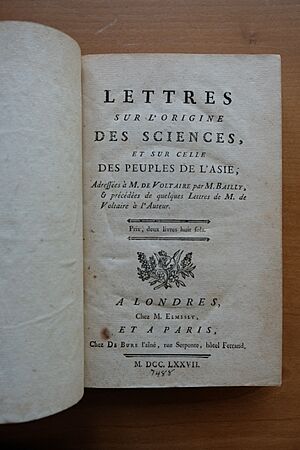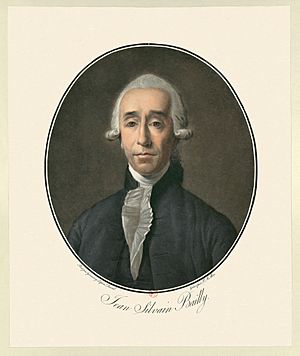Jean Sylvain Bailly facts for kids
Quick facts for kids
Jean Sylvain Bailly
|
|
|---|---|

Portrait by Jean-Laurent Mosnier, 1789
|
|
| Mayor of Paris | |
| Preceded by | Jacques de Flesselles (Provost of the Merchants) |
| Succeeded by | Jérôme Pétion de Villeneuve |
| 1st President of the National Constituent Assembly | |
| In office 17 June 1789 – 3 July 1789 |
|
| Preceded by | Office established |
| Succeeded by | Jean Georges Lefranc de Pompignan |
| Deputy of the Estates-General | |
| In office 5 May 1789 – 9 July 1789 |
|
| Constituency | Paris |
| Personal details | |
| Born | 15 September 1736 Paris, France |
| Died | 12 November 1793 (aged 57) |
| Cause of death | Guillotined |
| Political party | Patriotic (1790–1791) |
| Residences | Paris (1736–1791) Nancy (1791–1793) |
| Alma mater | Academy of Sciences French Academy |
| Profession | Astronomer, mathematician, politician |
| Signature |  |
Jean Sylvain Bailly (born 15 September 1736 – died 12 November 1793) was a French astronomer, mathematician, and important political leader during the early part of the French Revolution. He is well-known for leading the Tennis Court Oath, serving as the first mayor of Paris from 1789 to 1791, and was later executed during a period called the Reign of Terror.
Contents
Bailly's Scientific Career
Jean Sylvain Bailly was born in Paris, France. His father and grandfather were artists who worked at the Louvre. At first, Jean Sylvain thought he would also become an artist. However, he became very interested in science, especially astronomy, thanks to the influence of Nicolas de Lacaille.
Bailly was an excellent student. He had a great memory and was very patient. He even calculated when Halley's Comet would appear next, in 1759. He also helped build an observatory at the Louvre. Because of these achievements, he was elected to the French Academy of Sciences in 1763. His reputation as a French astronomer grew across Europe. In 1777, he even hosted Benjamin Franklin at his home.
Bailly's Scientific Writings
Bailly published his book Essay on The Theory of the Satellites of Jupiter in 1766. He also wrote On the Inequalities of Light of the Satellites of Jupiter in 1771. In 1778, he became a foreign member of the Royal Swedish Academy of Sciences.
Bailly also became famous for his literary works. He wrote Eulogies (speeches praising people) for important figures like King Charles V of France and Molière. These were published in collected forms. He was accepted into the Académie française in 1784 and the Académie des Inscriptions in 1785.
After this, Bailly focused on the history of science. He published A History of Ancient Astronomy in 1775, followed by A History of Modern Astronomy (in three volumes) in 1782. He also wrote Discourse on the Origin of the Sciences and the Peoples of Asia (1777) and A Treatise on Indian and Oriental Astronomy (1787).
Bailly During the French Revolution
Jean Sylvain Bailly quickly rose in politics. He was elected as a deputy for Paris to the Estates-General of 1789 on 20 May 1789. Soon after, he became the first president of the National Assembly (French Revolution) on 3 June 1789.
He led the famous Tennis Court Oath on 20 June, where members of the Third Estate swore not to stop meeting until they had written a new constitution for France. Bailly was the first to take this oath. In the National Assembly, Bailly helped pass a law that made Jewish people French citizens on 17 September 1791. This removed special taxes and old rules against them.
Bailly was a member of the Club de 1789, a well-known political group. Even though his duties as mayor limited his time, he became the club's presiding officer by May 1790. In 1791, he also joined the Jacobin Club, but he was not very active in it.
After the storming of the Bastille on 14 July 1789, Bailly became the first mayor of Paris under the new system of the Commune.

Bailly as Mayor of Paris
Bailly took office as the mayor of Paris on 15 July 1789. Two days later, Louis XVI met him at the Hôtel de Ville to show support for the Revolution. Bailly presented the King with the new symbol of the revolution: the cockade of France.
As mayor, Bailly was criticized by some, like Camille Desmoulins and Jean-Paul Marat, who thought he was too conservative. Bailly always tried to make the mayor's office strong and limit the power of the General Assembly of the Commune. He wanted to create a central government in Paris where his orders would be followed. However, many Parisians did not like this idea.
Keeping Order in Paris
Jean Sylvain Bailly wanted to be in full control of the Paris administration. He believed that the mayor should be the main leader, guiding all decisions and ensuring orders were carried out. He felt the mayor knew best about difficulties and dangers.
Addressing the Food Crisis
In the early years of the French Revolution, Paris faced a big food shortage. Bailly worked hard to fix this problem. He had deputies collect grain that was being hidden. He made farmers sell their wheat and helped bakers get supplies first at markets.
Convoys carrying grain were often attacked. To stop this, Bailly signed a rule that fined anyone who blocked these convoys. He not only managed the city's grain supply but also imported grain from Africa. By February 1790, the food situation in Paris had improved.
Strengthening the National Guard
The National Guard, formed during the revolution, was weak and lacked money. Lafayette, the leader of the militia, struggled to get funding. Bailly understood how important it was to have a well-equipped military.
In late 1789, Bailly helped get ammunition for the troops. He was also involved in creating the National Guard department, which aimed to arm the military. Bailly also gave orders to Lafayette to help keep peace in the city. He used troops to guard prisons, collect taxes, and prevent beggars from gathering in the city.
Managing Church Property
To try and fix France's money problems, the National Assembly took control of church property. They planned to sell it using special bonds called "assignats." On 10 March 1790, Bailly and the Municipal Bureau suggested that Paris be given 200 million livres worth of church land to sell. They would keep 50 million livres for their work.
The National Assembly agreed to this plan. On 2 August 1790, Bailly was reelected as mayor. He allowed people to start buying church property. Within a year, 28 million livres worth of land had been sold. Bailly's idea successfully raised money for Paris and the French government.
Bailly's Fall from Power
After the royal family tried to escape the country, Bailly tried to calm the growing crowds who wanted the King to step down. On 17 July 1791, tensions were high. People suspected of criticizing the government were being questioned.
Bailly heard about a large gathering at the Champ de Mars. Citizens were meeting there to sign petitions asking for the King to be removed. Bailly declared martial law and ordered the National Guard to break up the crowd. This led to violence, and many people died. Bailly and Lafayette were blamed for this event, which became known as the Champ de Mars Massacre. Revolutionaries saw it as an example of government oppression.
Because he became very unpopular, Bailly resigned on 12 November 1791. Jerôme Pétion replaced him four days later. Bailly moved to Nantes, where he wrote his Mémoires d'un Témoin (Memoirs of a Witness). This book tells the story of his public life but was never fully finished.
Bailly's Execution
In July 1793, Bailly left Nantes to visit his friend Pierre-Simon Laplace in Melun. However, he was recognized there and arrested. On 14 October, he was pressured to testify against Marie Antoinette but refused.
On 10 November 1793, he was brought before the Revolutionary Tribunal in Paris. He was quickly tried and sentenced to death the next day. On 12 November 1793, he was executed by guillotine at the Champ de Mars. This location was chosen symbolically because it was where he had ordered the troops to fire on the crowds.
The small red flag he had used to give the order to fire was tied to the cart that took him to his death. It was burned in front of him before he was executed. Before he died, he had to endure freezing rain and insults from the angry crowd. When someone shouted, "You tremble, Bailly?" he famously replied, "Yes, but it is only the cold."
Images for kids
See also
 In Spanish: Jean Sylvain Bailly para niños
In Spanish: Jean Sylvain Bailly para niños




